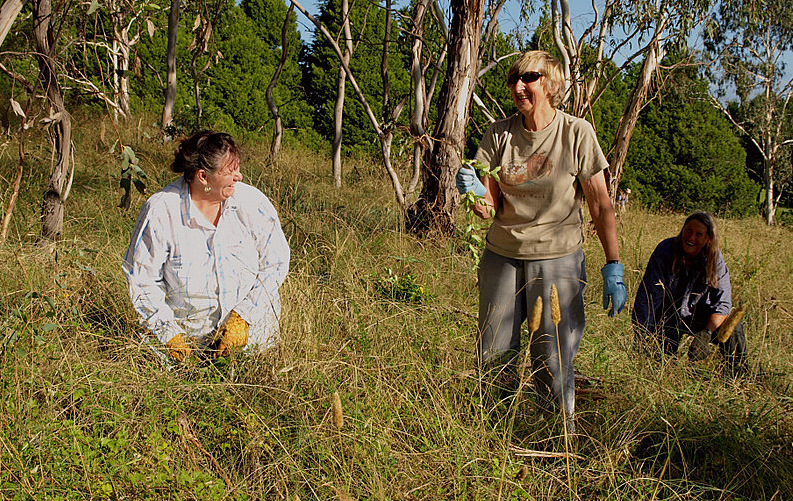 Hello bushcarers,
Hello bushcarers,
There was a fire towards the southern end of the reserve on Wednesday evening. It burnt part of the really high conservation value woodland and part of a 40-year old revegetation area before the fire brigade put it out . I have said more about the burnt area at the bottom of this post*.
The Next working bee in Snow Gums will be on Sunday 20th March between 9am and 1pm. Please confirm if you can come. There will be some hand weeding we can do even if it doesn’t rain first and there are one or two steps that could be replaced. If it does rain we can cut and poison small woody weeds (if it doesn’t rain, by the 20th the plants may not be growing sufficiently actively to take herbicide down to the roots). We will meet at the southern end of the reserve above 54 Markham St. Please wear closed shoes and sun protection.
Anyone able to come on Friday mornings is welcome to join with those of you who already work in the bushland around Apex Lookout in Drummond Park. We meet at or soon after 9.30 at the Lookout. Please tell me if you hope to start coming occasionally or regularly.
Regards, Kate Boyd
Armidale Tree Group bushland regeneration volunteer group
* The bushfire on 2/3/2016 was towards the southern end of Snow Gums Bushland Reserve at the top of the slope under the Snow Gums and into part of the former quarry that we revegetated in 1976-early ‘80s. None of this area had been burnt since before 1957 and it has hardly been grazed since 1968 except by invertebrates.
The natural bushland section had a thick cover of diverse native grasses, lots of herbaceous wildflowers, and prostrate or low shrubs (Pultenaea microphylla, Hovea linearis, Pimelia linifolia, Hibbertia obtusifolia, Cryptandra amara, Brachyloma daphnoides, Lissanthe strigosa and probably Leucopogon sp aff fraseri). There was also a mid-storey in part of this burnt area of Jacksonia scoparia, which has been semi-stable for 40 years and Acacia rubida, which has been expanding since planted at the edge of the revegetation area nearly 40 years ago. The fire only burnt up 1 or 2 of the trunks of the Ribbon and Snow Gums but there will have been enough heat from the wattles and some dead wood to scorch some foliage. There were ants that were annoyed by partial burning and moving or hosing of the wood that had been a roof over their nest. There is still a little wood and the fire only burnt the top end of the biggest log up there. There was only a gentle breeze so the fire only spread to one side of the walking track and part way down the hill, part way into the top part of the reveg area before the fire brigade got their 4WD truck in and squirted 5000 litres of water on it. The wooden steps ATG built for Council were not burnt.
I had noticed that the ground cover had become thicker over the last 40+ years in both the natural woodland and the revegetation area. There was a monitoring plot in the natural part of the burnt patch but it hasn’t been monitored since 2004. There were not many weeds apart from a few hawthorn and pistacia seedlings – hopefully they may have been killed. It will be interesting to see what grows back first and what flowers in the next couple of years. There was a Diuris orchid that flowered in about 1973 but hasn’t been seen since –we will have to look frequently for it over the next few years to see if it reappears! It would be good if we can establish plant monitoring plots in both the burnt area and unburnt areas.
In 2013 and 2014 there were several fires in Snow Gums Reserve and Drummond Park. In 2015 there were no fires in these grassy woodland remnants but 1 in the mountain-bike track area between them that would have got into the bush if not stopped. In the last 15 years there have been fires in many parts of these reserves: some small areas have been burnt more than once. All the fires in the last 15 years were deliberately lit. Only on one occasion was fire planned for bush regeneration (by me with ecological and fire brigade help in about 2004). There have been too many fires since then. We have too little woody animal habitat on the ground in our woodlands and the fires tend to reduce this further. While people occasionally create a campfire near the Lookout, few if any of the grass fires were accidental escapes. The arsonists may have been adults, teenagers or children.
If you see suspicious behaviour in bushland, the creeklands or other areas with dry grass please tell the police as they are keen to put evidence together.